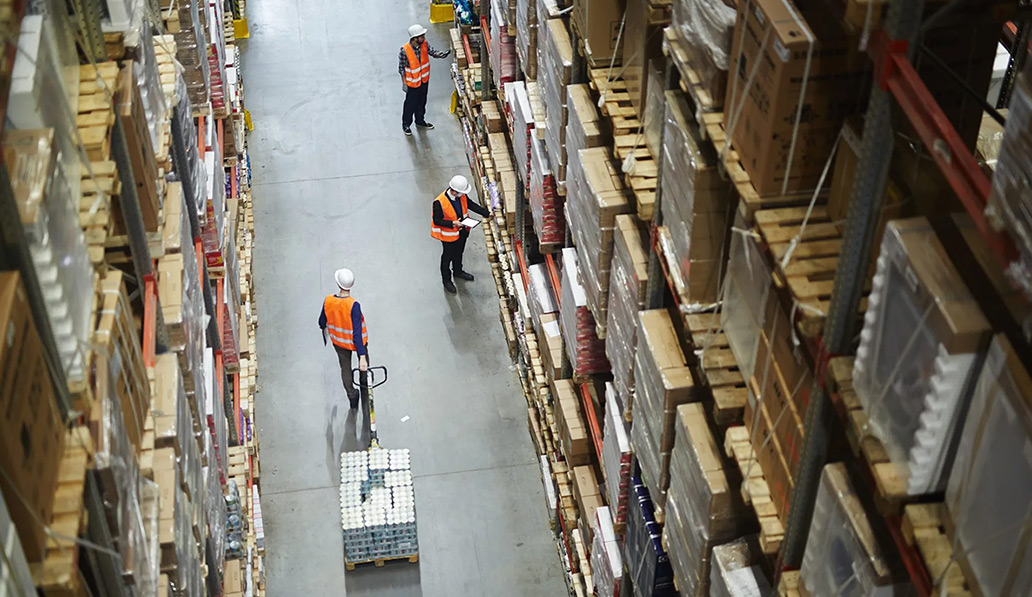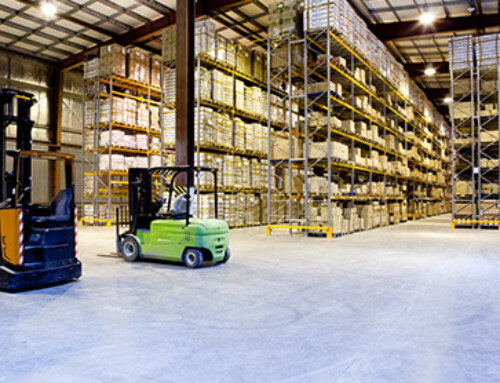Introduction/Overview
A safe, well organized and orderly Warehouse is the key to a successful stocking and dispatch operation. Operations in the warehouse include receiving, putting away, storing & distribution within the facility; or dispatch for shipment. For this purpose, a number of resources including equipment like manual and electric hand pallet trucks, diesel or electric forklifts, reach trucks, stackers, etc. as well as a large number of manpower is required for effective movement of the materials.
Receipt and Unloading of Goods is the first warehouse process and one of the most crucial. To perform the receiving process properly, the warehouse should be able to verify that it has received the right product, in the right quantity or number, in the right condition, and at the right time.
Put-away is the second warehouse process and is the movement of goods from the point of unloading to the desired location for warehouse storage.
Storage is the warehouse process in which raw materials after receipt, or finished goods after production, are placed into their most appropriate storage space. When done properly, the storage process makes optimum use of and fully maximizes the available space in your warehouse and increases labor and machine efficiency for material handling.
Shipping is the final warehouse process and the start of the journey of goods outward from the warehouse to the customer, port or central stocking point. Shipping is considered successful only if the right order in the right quantity is sorted and loaded in the least possible time.
With so much going on & so much to keep track of, a warehouse may have more potential for accidents than another area with limited functions. In fact, warehouse fatalities jumped from 11 to 22 annually in a span of just two years (2015-2017), according to the Bureau of Labor and Statistics. The most recently released injury rate is 5.1 per 100 full-time warehouse workers, which is the same injury rate as farming.
So it is especially important to pay close attention to safety measures and practices in a warehouse operation.
General Safety
- Wear proper safety shoes to prevent Slips, trips& falls (closed toe, good traction & laced).
- Ensure warehouse raw material, finished goods etc. are secured properly in order to prevent falling.
- Do not jump of the dock.
- Do not climb on racks, use designated walkways, know where all the exists are & the emergency plan of action.
- Clean up grease &oil spills since equipment leaks are a normal occurrence.
- When you notice a spill; your first step should be to find its source and fix it at the same time, use “pigs” (round absorbent material) to catch oil so that it doesn’t get into passageways. Always check a chemical’s Safety Data Sheet (SDS) before touching.
- Use proper safety measures to identify and highlight wet and narrow areas in the warehouse such as signage, barricading, warning signs etc.
- Keep passageways clear from debris at all times because that creates a significant trip hazard, and ensure debris like strapping, stretch wrap and broken pieces of pallets that might get collected are picked up immediately.
- The organization should provide a perception of cleanliness, every worker should play a role in housekeeping even if that means keeping his or her own workspace clean, housekeeping should be an ongoing process, not a one-time practice.
- Report any improperly maintained area leading to unsafe condition immediately.

Area of Operation in warehouse: Docks, Storage area, Conveyor area
Dock area activities are loading & unloading, material shifting
Hazards involved in loading & unloading & material shifting: Fall of Material, worker falling off the dock, forklift running off the dock, sprains and strains from improper lifting or handling of material, Slip trips & falls.
Preventive Measures
- Center the load on the forks as close to the mast as possible to minimize the potential for the truck tipping or the load is falling.
- Avoid overloading a lift truck because it impairs control and can potentially causes tipping over.
- Adjust the load to the lowest position when traveling.
- Drive forklifts slowly and cautiously.
- Keep the forklift clear of dock edges.
- Provide visual warnings near dock edges.
- Rope off areas where employees could fall 4 feet or more, such as exposed or open bay doors.
- Prohibit employees from jumping off docks.
- Secure dock pallets and ensure they can safely support the load.
- Ensure ladders and stairs used at docks meet OSHA guidelines. https://www.osha.gov/Publications/ladders/osha3124.html
- Ensure safe lifting method like maintaining neutral back and bending with your hips & knees and changing direction with your whole body rather than twisting.
- Ensure proper housekeeping.
Storage area activities are material shifting & stacking
Hazards involved in material shifting: Worker struck by forklift, collision of forklift with each other, falling of stack material, caught in/on between, toes, feet and lower legs being bumped or crushed by hand truck, dollies, slips, trips, and falls.
Preventive Measures
- Workers to be educated to use designated walk or pathways while moving around the warehouse & priority should be given for forklift passage first.
- All forklift operators to be properly educated, trained and certified on safety knowledge as well as compliance during operations be monitored.
- Do not allow anyone under the age of 18 to operate a forklift. Implement a preventive maintenance and inspection program to ensure forklift trucks are in good working order. Inspect forklifts before each use.
- Ensure convex mirrors on blind spot turns in the facility.
- Always drive safely, never exceeding the speed limit.
- Ensure that stacks are stable and self-supporting. Stack bags and bundles in interlocking rows to keep them secure.
- Stack bagged material by stepping back the layers and cross-keying the bags at least every ten layers (to remove bags from the stack, start from the top row first & always from one side).
- Practice pyramid shaped stacking of goods where possible.
- Ensure you don’t place fingers or hand between the load & hand truck structure.
- Ensure hand trucks or trolleys that are not in use are parked in designated areas with wheels locked to avoid movement.
- Keep the center of gravity of the load as low as possible. Put heavy objects below the lighter ones. When loading, keep feet clear of the wheels.
- Ensure the load is placed well forward so the weight will be carried by the axle, not the handles.
Conveyor area activities are generally manual handling of material
Hazard involved in manual handling of material: pinch-point, nip-point, musculoskeletal disorders through repetitive motions or awkward positions.
Preventive Measures
- Inspect conveyors on a regular basis.
- Guard pinch points – now what is “pinch-point”? Pinch-point (also called a nip point), is a point on a machine where a person or a part of their body can get caught in between moving parts.
- Gears, rollers, belt drives, and pulleys conveyors are all examples of typical pinch points in the workplace. OSHA standard 1910.211 provides guidance on what constitutes a nip point.
- Prohibit wearing of jewelry or loose clothing near conveyors.
- Strictly prohibit riding on a conveyor belts or crawling across or under them.
- Develop and implement proper procedures for locking out conveyors and train employees on them.
- Ensure proper lighting and proper working surfaces in areas near conveyors.
- Whenever possible, eliminate the need for manual lifting by using forklifts, pallet jacks, automatic palletizers, and other equipment.
- Reposition shelves or bins to reduce lifts from the ground and from shoulder height.
- Ensure always use the legs to lift, keeping the back in a neutral position.
- Ensure before lifting, check to estimate the size and bulk of the load to determine if and how the weight may shift.
- Ensure a good grip before lifting; if the load is too heavy, call for help.
- Ensure do not shift at the waist while carrying the load, instead pivot with the feet and take small sure steps.
- Ensure floors clear of all slip, trip, and fall hazards.
- When planning a job, factor safe work practices into the mix.
What if an emergency occurs ?
- Finally, ensure you have a warehouse-specific emergency plan that describes what is expected of employees in the event of an emergency or disaster. As part of the plan, your employees need to be trained on:
- When and how to call emergency responders
- The location of emergency exits and evacuation procedures, including where to gather after the building is evacuated, and procedures to account for all employees and visitors, ensure a chart is displayed in the facility for the same.
- The location and use of fire extinguishers and other emergency equipment, and who is trained to use them and when; and
- Procedures for reporting incidents to management, including after-hours phone numbers and the type of incidents that should be reported.
When it comes to warehouse safety there are many benefits that are often overlooked. Safety procedures are frequently disregarded in a variety of workplaces due to insufficient time, inadequate resources or an opportunity to cut corners in an attempt to save money. However, when safety procedures are soundly implemented there are major benefits such as higher employee satisfaction as well as increased productivity. Training & guidance play an important part in ensuring safety at work. A safe and healthy workplace benefits everyone. It means the staff feels well and work flows smoothly.
Aatish Zarapkar
EHS Head
UNILIFT Cargo Systems Pvt. Ltd.




